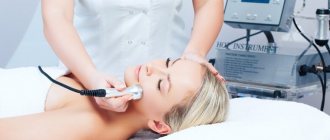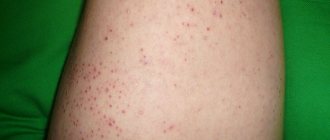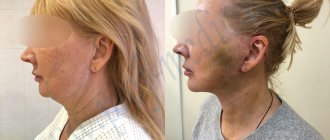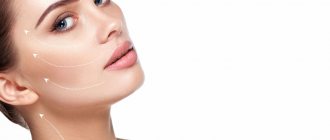With age, due to deteriorating nutrition, the skin inevitably loses its elasticity, it becomes thinner, becomes flabby and unattractive in appearance. The subcutaneous fat layer, on the contrary, increases, due to which the volume of tissue shifts from the area of the zygomatic bone downwards. The area of the middle third of the face that is most susceptible to deformation is the area where the increased load and impact of almost all facial muscles occur. Fortunately, aesthetic surgery does not stand still; today, to rejuvenate the problem area, an operation called “check-lifting” is performed, literally erasing years from the face to the delight of beautiful women.
What is a check-face lift: indications and contraindications
- First of all, you need to understand what this beauty procedure is.
- Check-lifting is not just one, but a whole set of procedures that are aimed at rejuvenating the middle third of the face.
This complex consists of the following procedures:
- Cheekbone lift
- Blepharoplasty of the lower eyelids.
- Circular facelift.
- Cheek lift.
This procedure makes it possible to significantly improve the appearance of the face, thereby rejuvenating a person by 5 or even 10 years.
Indications for check-lifting are as follows:
- Loss of elasticity in the soft tissues of the face.
- Drooping and sagging cheeks.
- Nasolabial folds too deep.
- Deepening of the nasolacrimal groove.
- Swelling under the eyes.
- The appearance of hernial “bags” under the eyes.
- Eversion of the lower eyelid.
Rejuvenate
Such surgical intervention is contraindicated if:
- The patient has a history of any sexually transmitted diseases, as well as infectious diseases during exacerbation.
- There are various diseases of internal organs that are chronic.
- There are diseases of the autoimmune system that directly negatively affect the condition of the skin.
- The patient has cancer and is undergoing chemotherapy.
- There are problems with blood clotting.
- There is an allergic reaction to the drugs used during surgery.
- There are any mental disorders and illnesses.
- Also, surgery cannot be carried out without the patient having a full package of necessary tests and examinations.
Check-lifting: preparation for the procedure, operation
Check-lifting, although a low-traumatic operation, is still an operation, so the patient must be prepared before it is performed. Preparation for a check-lift is as follows:
- Initially, a person who has decided to make himself more beautiful and younger needs to visit a therapist and consult with him about whether it is possible in principle to carry out such a procedure.
Also at this stage you will need to do a number of tests and examinations:
- General and biochemical blood test.
- Cardiogram to check the functioning of the heart.
- X-ray of the lungs to rule out diseases of this organ.
- Test for HIV, hepatitis and sexually transmitted infections.
Before carrying out, the zones are divided.
If, after passing all the tests and conducting other examinations, the doctors come to the conclusion that there are no contraindications to the check-lifting, you can proceed to the next stage of preparation:
- A few days, or better yet a week before the day of surgery, you need to eliminate all alcohol from your diet, and also stop smoking, taking contraceptives and any medications that thin the blood.
- Next, the patient will have a mandatory consultation with a surgeon. This will help the doctor understand exactly what the patient expects from the procedure. The specialist also evaluates the amount of work and guides the person regarding the possible results of the procedure.
- A meeting with an anesthesiologist is also required This is necessary in order to analyze the possibility of putting a person under anesthesia.
- In the evening before the procedure, it is advisable to take a mild sedative so that the body relaxes and rests before the upcoming operation. You should also refrain from eating heavy, fatty foods, and you should also limit the amount of water consumed.
Meetings with doctors are inevitable before the operation.
The course of the operation can be different and depends on what kind of manipulations the doctor will perform, the characteristics of the patient’s face, etc. In general, the algorithm of actions during a check-lift is as follows:
- The patient is put under anesthesia. Most often it is general, but sometimes local can be used according to indications.
- Next, markings are applied to the patient’s face.
- The specialist then makes 2 small incisions along the lower eyelid and uses equipment such as an endoscope to separate the muscle from the bone. After this, the muscles move to the desired place, position and are fixed there. Fixation occurs due to the introduction of endotins - thin plates with denticles.
Incisions are made
- Thanks to the material from which they are made, such plates dissolve on their own within a year, and in their place a framework of connective tissue is formed.
- After all the necessary muscles are tightened, the doctor applies the required number of stitches and covers the area where surgery was performed with a sterile bandage.
- During the normal course of the operation, the procedure lasts approximately 1-2 hours.
- Next, the person is taken out of anesthesia and observed how the operated areas behave.
How is it carried out?
The operation process consists of several stages. Before prescribing this particular type of skin rejuvenation, a consultation is held with a cosmetologist or plastic surgeon, who will visually assess the general condition of the skin. Next comes the preparation, after which the operation itself takes place. After surgery, there is a rehabilitation period, which depends on the area of impact and the area of skin that was operated on.
Preparation
During the preparatory stage, certain tests are prescribed that will help identify the presence of diseases that are contraindications to this type of exposure. The most informative are biochemical and general blood and urine tests. Also, with their help, the degree and quality of functioning of the liver and kidneys is revealed, and the Rh factor of the patient’s blood is determined.
To get the most comprehensive picture of your health, you should be examined by a therapist and an endocrinologist, gynecologist and dermatologist. Immediately before the operation, it is recommended to give up cigarettes, since their smoke contains substances that prevent the rapid healing of injuries. The use of alcohol is also limited due to the impossibility of joint use of anesthesia.
Algorithm
Before surgery begins, anesthesia is administered. Intravenous anesthesia can be used, but some surgeons recommend using local anesthesia to reduce the negative effects on the body.
During the operation, part of the muscles, excess fatty tissue and fragments of sagging skin that has lost its elasticity are excised.
Result of check-lifting
Rehabilitation
The duration of the rehabilitation period depends on the area of impact. The stitches are removed after 1.5-2 weeks; during recovery, you should avoid visiting the bathhouse, swimming pool, and solarium. The incision sites must be treated with disinfectants.
A check-lift is a surgical facelift in the middle third, which this video will tell you about:
Check-lifting: rehabilitation by day, advice from doctors on recovery
As after any operation, after a check-lift the patient undergoes rehabilitation. It must be said that, unlike many other surgical interventions, this is tolerated quite well, and serious complications are extremely rare.
- For safety reasons, the patient spends the first day, sometimes several days, in the hospital. This is necessary in order to keep the situation under control and observe how the body reacts to the surgical intervention.
- Further, if the patient has no complaints about his health, rehabilitation is carried out at home.
- Bruising and bruising may occur at the operated site for several days . In this case, the patient is prescribed painkillers. Most often, such phenomena disappear a week after the procedure.
Bruising may occur
- On day 7, as a rule, the stitches can be removed. This is only necessary if, for some reason, non-absorbable suture material was used. If the material dissolves on its own, there is no need to remove sutures.
It is also very important to consider and follow the following recommendations when recovering from surgery:
- The first time after the procedure, about 1 month (however, this is individual, depending on the body), you cannot play sports, and you also need to exclude any physical activity.
- You should refrain from wearing contact lenses for 2-3 weeks .
- It is necessary to avoid exposure to high temperatures on the skin of the face. That is, trips to the bathhouse, solarium, etc. should be temporarily postponed.
- For 2-3 weeks after a check-lift, try not to make sudden movements. You cannot bend over sharply, turn your head, etc.
No sudden movements
- Also, be sure to avoid sunbathing for a while.
- Another restriction is visiting the pool . This can be done at least a month after the operation and only if the wounds heal well and quickly.
- For the first 2 weeks after a check-lift, you need to sleep half-sitting and only face up. Failure to follow this recommendation may result in seams coming apart.
- In general, rehabilitation lasts 2-4 weeks.
Rehabilitation
Even after such a low-traumatic intervention as a check-lift, rehabilitation is necessary. Although it lasts only 2 - 3 weeks and is tolerated quite easily. The first day the patient usually remains in the hospital. By evening you can eat and drink water. The pain is mild, swelling is noticeable on the face, and superficial hematomas are noted.
After a check lifting operation, recovery is accompanied by following simple rules:
- the sutures must be cared for using medications prescribed by a doctor, taking care to prevent the solution from penetrating into the eyes;
- Avoid contact with water for at least 5-7 days;
- on the 5th - 7th day you need to see a doctor to remove the stitches;
- the face must be protected from mechanical and other damage;
- overheating of tissues should be avoided, that is, for now, avoid baths, hot baths, solariums and exposure to the sun (tanning is prohibited for six months);
- it is necessary to give up sports for a month, not to be overloaded with housework (bending over is especially undesirable);
- You should also refrain from using cosmetics until the stitches are healed;
- Non-contact procedures are useful during this period, that is, ultrasound, microcurrents, and later fractional thermolysis to smooth out seams.
About rehabilitation after check-lifting, watch this video:
Check-lifting - possible complications after surgery: how long does it take for swelling to go away after check-lifting?
It would be wrong to say that complications cannot arise after a check-lift. Since a check-lift is an operation, complications may arise after it, but this is rare.
There are practically no complications.
Most often the following complications may occur:
- Swelling and bruising. Such phenomena after a check-lift can, in principle, be considered the norm, since the skin and muscles are injured during the operation. However, most often after a week, swelling and bruising go away on their own.
- Infection. Such negative consequences are much less common and to avoid them after a check-lift, doctors prescribe antibiotics to the patient.
- Appearance of scars.
- Slow resorption of endotin. If endotin does not resolve on its own within the time period specified by the doctor, it is removed.
- Impaired blood flow. This happens when endotin is attached in the wrong place. Because of this, the patient's skin becomes thinner and hair may fall out. This complication is eliminated by moving endotin.
- Changing the shape of the eyes. Such consequences arise if, for some reason, during the operation the patient had too much skin removed or it was stretched too much. It is worth knowing that such a complication is solely a medical error and unprofessionalism of a specialist.
- "Round" eye. This problem usually occurs due to scarring of the skin and removal of too much skin.
- As for swelling , this question interests everyone who decides to undergo such a procedure. If the operation was successful (and this is what happens in most cases) and after it the patient follows all the rules of rehabilitation, the swelling will subside in about 3-10 days.
Check-lifting: benefits and cost of the procedure
Many people ask the question: “Why is this procedure so popular today? Why do so many people want to have this type of surgery?” The answer is quite simple, because check-lifting has many advantages over other procedures.
Here are the main ones:
- No serious complications. As a rule, after a check-lift there are rarely any complications, with the exception of swelling and bruising, which appear after almost any surgical intervention.
- Long lasting effect. The procedure makes it possible to rejuvenate your facial skin for many years.
- Simple recovery process. Rehabilitation is quite simple and fast. The patient does not need to stay in the hospital for a long time or attend any procedures for recovery.
- Surgery is performed using an endoscope . This makes it possible to minimally injure the patient’s skin and face.
The results are impressive.
As for the cost of check-lifting, many consider it a disadvantage of the procedure:
- The cost of a check-lift will depend on various factors. For example, the patient’s wishes and the amount of work will be taken into account.
- It is also of great importance where exactly the operation will be performed: in a large or small city, with a well-known or not-so-famous surgeon, etc.
The minimum cost of a check-lift is approximately 50,000 rubles. This cost will be if the minimum amount of work is selected.
- If the volume of work is large, there are certain features, etc., the cost can reach 150,000-300,000 rubles.
- At the same time, we recommend that before agreeing to carry out the operation, you clarify what exactly is included in this cost. Why? Because everything is different in different clinics.
- At one hospital, the cost of the procedure includes the consultation, the operation itself, and the time spent in the hospital. In another hospital, this cost may only include the operation itself and nothing more.
- In any case, experts urge everyone who wants to undergo a check-lift to be prudent and not agree to have the operation performed in dubious clinics where it is cheaper.
The materials that are used during the procedure are very expensive, so it is obvious that a check-lift cannot be cheap.
Recovery after surgery
Immediately after the operation, a pressure bandage is applied to the operated area. This is necessary to reduce bruising and swelling. The pain syndrome will be relieved with an analgesic. You need to lie and sleep with the head of the bed raised. If there are no complications, you can go home on the second day, where you will need to strictly follow all the surgeon’s recommendations and restrictions.
The sutures are removed after 8-10 days. Complete recovery takes 6 months, after which the final result of the plastic surgery is assessed.
0.0/5 rating (0 votes)
Check-lifting: before and after
The results of a check-lift are almost always pleasantly surprising, because the person who has had such a procedure looks 5-10 years younger:
- Despite the fact that the operation was performed, the face looks natural, not “tightened”, the skin becomes elastic and smooth.
- Natural facial expressions are completely preserved.
- Nasolabial folds and tear troughs become almost invisible.
- The face acquires a clear contour, the cheeks stop sagging, and the cheekbones become more pronounced.
- Folds on the face are smoothed out and wrinkles are eliminated.
- “Bags” under the eyes disappear.
Result
Improvement
Difference
Before and after
Noticeable results
Methodology
The operation can be performed either under general anesthesia or using local anesthesia. The choice depends on the wishes of the client, his state of health, the duration of the intervention and the volume of problem areas.
On average, the operation takes about 40 – 100 minutes.
The check-lifting algorithm is quite simple:
- A miniature incision is made along the lower eyelid line.
- An endoscope and a surgical instrument are inserted into the puncture.
- The muscles are tightened, returning to their natural position.
- Subcutaneous fatty tissue is redistributed, its excess is carefully removed.
- Endotin fixatives are installed.
- Cosmetic sutures are placed at the incision sites.
How long does the effect of check-lifting last?
As mentioned earlier, the long-lasting effect of check-lifting is the advantage of this procedure:
- As a rule, the effect lasts quite a long time. Experts say 5-10 years , depending on the characteristics of the body, the general health of the patient and, of course, facial skin care.
- If care is not carried out properly, the effect may last significantly less.
- Also, the effect may last much less if the doctor made mistakes during surgery or if serious complications arose after the operation.
At what age is it better to have a check-lift?
There is no specific age at which it would be necessary or unnecessary to do a check-lift, because we are all different. For some, the first wrinkles appear at the age of 25, and for others at 40.
- Despite the above, doctors do not recommend this procedure for people under 30 years of age and over 65. Why? Because before the age of 30, as a rule, the skin looks quite fresh and elastic, so there is no need to tighten it and refresh it. In this case, the effect may be quite insignificant.
- Well, after 65 years, the skin, in principle, can no longer look the same as it looked at 25-30 years old. Of course, there will be an effect from check-lifting, but it is important to understand that this procedure only makes flaws invisible for a while, but it does not slow down or stop the aging process.
Based on this, we can say that the most suitable age for check-lifting is 35-55 years.
Blepharoplasty and check-lifting: differences
Blepharoplasty and check-lifting are two different procedures, however, during check-lifting, patients very often undergo lower eyelid surgery.
So, let's figure out how these procedures differ from each other:
- Blepharoplasty is a procedure that can be used to change and correct the shape of the eyes, eliminate bags under the eyes, sagging skin around the eyes, wrinkles, etc.
- Check-lifting, as we already know, is a procedure that allows you to rejuvenate and tidy up the entire middle third of the face (the main attention is paid to the cheeks, cheekbones, nasolabial folds). Actually, we said earlier that check-lifting is not just one procedure, but a whole complex, and blepharoplasty is included in this complex.
Blepharoplasty is included in the check-lifting complex
- Otherwise, the two procedures are similar. Blepharoplasty is considered a low-traumatic operation and lasts approximately 1 hour. The recovery period does not last more than 2-3 weeks.
Questions and answers
What is the difference between a check-lift and an endoscopic lift?
Check-lifting is a variant of endoscopic lifting, but it is limited to the middle third of the face.
How long does the effect of the procedure last?
Endotins dissolve after a year, but the connective tissue formed in their place allows the results of the operation to be extended for another 5-7 years.
How long does the swelling last after surgery?
Swelling persists for about a month, its greatest manifestation is noted in the first week.
How to choose a good surgeon?
Important selection criteria are the reputation of the clinic, the doctor’s work experience, and positive customer reviews. To achieve all the stated results, it is important to contact the best check-lifting specialists, since this operation is quite complex. For example, Dr. Zakharov from the Institute of Plastic Surgery and Cosmetology is considered a professional with an excellent reputation and many years of practice.
Check-lifting: reviews
- It would be unfair not to say that 90% of check-lift reviews are positive. Negative reviews are extremely rare and most often in cases where the procedure was performed by an unqualified doctor or with low-quality materials.
- People who have undergone such an operation truly confirm that the procedure is not very painful, and recovery is quick and easy.
- Swelling and bruising go away within 3-7 days after the check-lift.
- The skin becomes smooth and elastic.
- The nasolabial fold disappears, the cheekbones become more noticeable and pronounced, the cheeks stop sagging and spoiling the appearance.
- Crow's feet disappear.
- In general, the face looks 5-10 years younger.
- The effect lasts for a really long time, at least 5 years.
Your face looks ten years younger
If you are still wondering whether you need this operation, we advise you to make an appointment with a doctor, discuss all the nuances and be sure to look at real “before/after” photos of the check-lift, well, further, the choice is yours.











